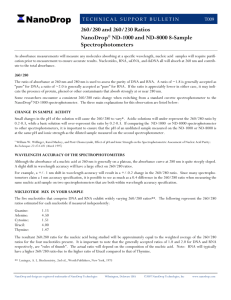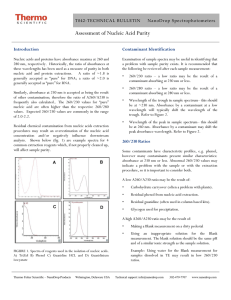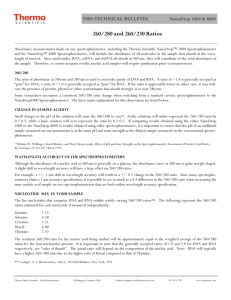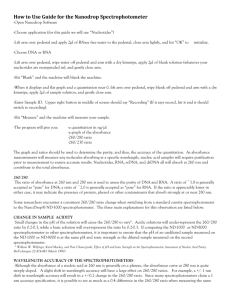Nucleic Acid 260/280 Ratio Interpretation - NanoDrop Lite
advertisement
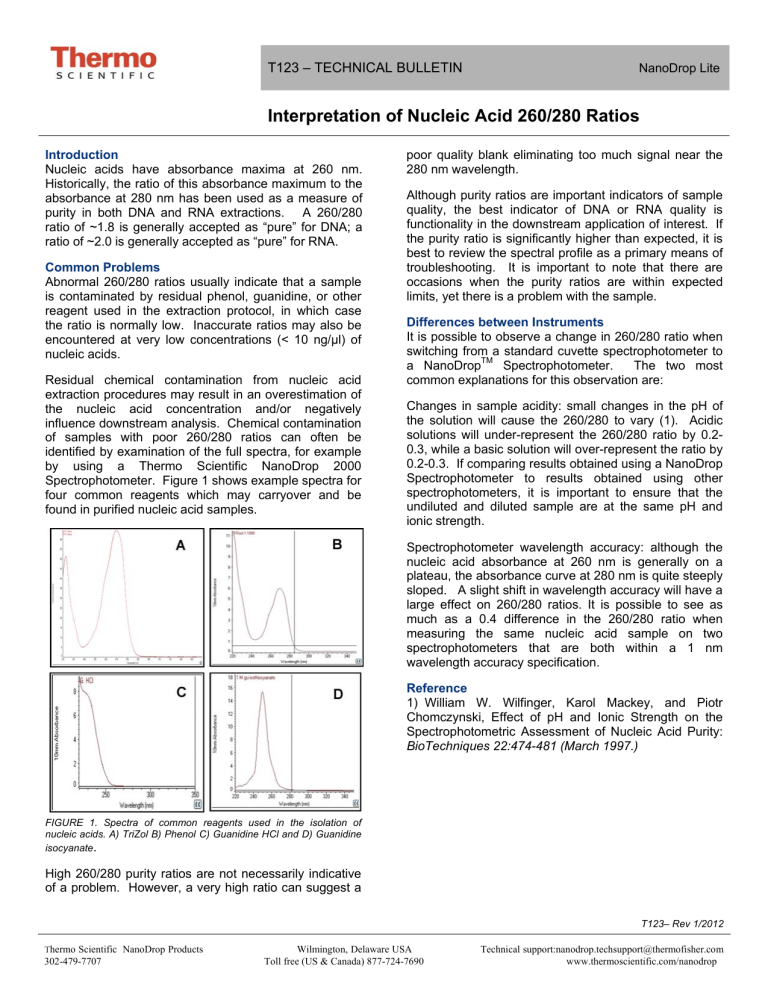
T123 – TECHNICAL BULLETIN NanoDrop Lite Interpretation of Nucleic Acid 260/280 Ratios Introduction Nucleic acids have absorbance maxima at 260 nm. Historically, the ratio of this absorbance maximum to the absorbance at 280 nm has been used as a measure of purity in both DNA and RNA extractions. A 260/280 ratio of ~1.8 is generally accepted as “pure” for DNA; a ratio of ~2.0 is generally accepted as “pure” for RNA. Common Problems Abnormal 260/280 ratios usually indicate that a sample is contaminated by residual phenol, guanidine, or other reagent used in the extraction protocol, in which case the ratio is normally low. Inaccurate ratios may also be encountered at very low concentrations (< 10 ng/µl) of nucleic acids. Residual chemical contamination from nucleic acid extraction procedures may result in an overestimation of the nucleic acid concentration and/or negatively influence downstream analysis. Chemical contamination of samples with poor 260/280 ratios can often be identified by examination of the full spectra, for example by using a Thermo Scientific NanoDrop 2000 Spectrophotometer. Figure 1 shows example spectra for four common reagents which may carryover and be found in purified nucleic acid samples. poor quality blank eliminating too much signal near the 280 nm wavelength. Although purity ratios are important indicators of sample quality, the best indicator of DNA or RNA quality is functionality in the downstream application of interest. If the purity ratio is significantly higher than expected, it is best to review the spectral profile as a primary means of troubleshooting. It is important to note that there are occasions when the purity ratios are within expected limits, yet there is a problem with the sample. Differences between Instruments It is possible to observe a change in 260/280 ratio when switching from a standard cuvette spectrophotometer to The two most a NanoDropTM Spectrophotometer. common explanations for this observation are: Changes in sample acidity: small changes in the pH of the solution will cause the 260/280 to vary (1). Acidic solutions will under-represent the 260/280 ratio by 0.20.3, while a basic solution will over-represent the ratio by 0.2-0.3. If comparing results obtained using a NanoDrop Spectrophotometer to results obtained using other spectrophotometers, it is important to ensure that the undiluted and diluted sample are at the same pH and ionic strength. Spectrophotometer wavelength accuracy: although the nucleic acid absorbance at 260 nm is generally on a plateau, the absorbance curve at 280 nm is quite steeply sloped. A slight shift in wavelength accuracy will have a large effect on 260/280 ratios. It is possible to see as much as a 0.4 difference in the 260/280 ratio when measuring the same nucleic acid sample on two spectrophotometers that are both within a 1 nm wavelength accuracy specification. Reference 1) William W. Wilfinger, Karol Mackey, and Piotr Chomczynski, Effect of pH and Ionic Strength on the Spectrophotometric Assessment of Nucleic Acid Purity: BioTechniques 22:474-481 (March 1997.) FIGURE 1. Spectra of common reagents used in the isolation of nucleic acids. A) TriZol B) Phenol C) Guanidine HCl and D) Guanidine isocyanate. High 260/280 purity ratios are not necessarily indicative of a problem. However, a very high ratio can suggest a T123– Rev 1/2012 Thermo Scientific NanoDrop Products 302-479-7707 Wilmington, Delaware USA Toll free (US & Canada) 877-724-7690 Technical support:nanodrop.techsupport@thermofisher.com www.thermoscientific.com/nanodrop
